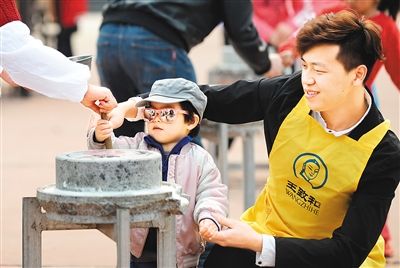Industrial development of folk culture needs inheritance, respect

A father helps his child grind soybean to make bean curd in celebration of the Spring Equinox on March 19 at Jiayu Village, Daxing District of Beijing.
Commercial exploitation of folk culture has become a major means of regional economic development in recent years. However, the excessive pursuit of profit has distorted the development of folk culture.
The boom of folk culture tourism shows that society is reevaluating folk traditions. Liu Delong, vice-president of the China Folklore Society, said the industrial development of folklore tourism has effectively protected the legacy of folk culture, satisfying the cultural needs of the public. However, limits should be imposed on some folklore resources. The overexploitation of folklore customs and festivals will often impair the essential attributes of folklore cultural heritage, Liu said.
Commenting on the phenomenon of fabricated folklore, Xu Ganli, an associate professor from the Institute of Folklore at East China Normal University, said folklore culture in the age of consumerism has become a resource to satisfy tourists’ desire for the simplicity of remote village life. Catering to consumers, folklore has been fabricated where such folklore phenomenon does not exist in local regions or among local ethnic groups, Xu explained.
Xu described the fabrication of folklore as “quasi-folklore.” The invention of folklore happens mostly in singing and dancing performances as well as the compilation of local figure stories or legends, the fabrication of strange customs and the shaping of a false folk cultural landscape. Usually, it is also evident in the beautiful clothing, romantic customs of marriage and love as well as original ecological and healthy “heirloom food” and local products carrying local culture, Xu said.
Liu said folklore evolves in the process of inheritance and new folklore culture continues to form in the process of utilizing folklore resources. Therefore, the folklore in industrial development cannot be simply regarded as “quasi-folklore” or even “pseudo-folklore,” Liu suggested.
Folklore tourism is not a process of pursuing truth but rather the practical activity of appreciating beauty, Xu suggested. Folklore culture invented in the process of folklore tourism might be accepted by local residents and eventually incorporated in the local cultural context. In other cases, they will be gradually abandoned and forgotten, Xu said.
Yang Dongli, an associate professor from the School of History and Culture at Shandong University, did not agree that industrial development of folklore makes it “pseudo-folklore.” If such forms of folklore are not imposed on the public—if they reflect the public’s natural feelings and are accepted and participated in by the public—they therefore represent “true folklore,” Yang said. Industrial exploitation brings new opportunities and ways to inherit and develop folklore tradition in many areas, injecting new vitality into folklore in new social environments and lifestyles, she added.
In the long term, protecting folklore cultural resources can be synergized with developing tourism. Under the joint pressure of public expectations to preserve the legacy, local governments’ desire to develop their economies and companies’ profit motives, the industrial exploitation of folklore is inevitable, Xu suggested.
Preserving the cultural spirit of folklore is the key to its industrial exploitation, Yang said. Effective measures should be taken to preserve cultural traits while avoiding damage to genuine public sentiment, she said.
Yang suggested that the government should play a role in planning, innovation, production and marketing of folklore cultural products, preventing the excessive commercial exploitation of folklore.

 PRINT
PRINT CLOSE
CLOSE